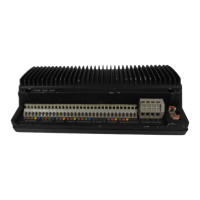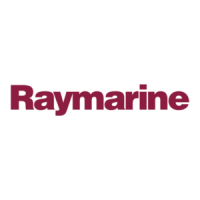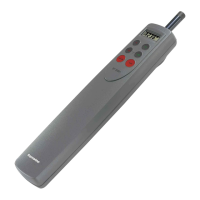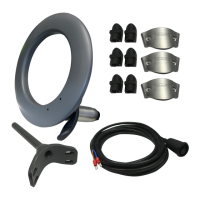Do you have a question about the Raymarine Autohelm 4000 and is the answer not in the manual?
Attaches to the vessel's wheel for manual steering engagement.
Specifies acceptable steering system turns and lost motion limits.
Details clamping the drive unit to wheel spokes using specific kits.
Guides cutting pedestal bracket pin length to suit pedestal dimensions.
Instructions for attaching drive unit to metal wheels using clamps and spacers.
Mentions an optional kit for wooden wheel attachment.
Placement advice for the control unit, away from magnetic interference.
Corrects motor drive sense if unit is mounted aft-facing.
Connects power supply and drive unit via waterproof connector.
Connects power supply cable to vessel's panel with fuse protection.
Details running the drive unit cable through the pedestal to the control unit socket.
Connects accessories like windvane and remote to the control unit socket.
Describes mounting the windvane mast and connecting the vane head.
Explains how the autopilot maintains course using fluxgate compass and microprocessor.
Details control functions via a six-button keypad for modes and course changes.
Describes using wind trim to maintain apparent wind angle automatically.
Explains the automatic tacking feature for changing course by 100 degrees.
Covers operating mode indication, handheld control, and navigation interface.
Details functional tests and initial rudder control settings.
Practicing steering using control keys and returning to automatic heading.
Explains how to disengage the drive for manual steering.
Describes how the system adapts to vessel pitch and roll over time.
Allows inhibiting automatic sea state control for maximum course keeping accuracy.
Guides performing an additional trial for the auto-tack feature.
How to disengage the drive unit for manual override.
Explains the alarm that sounds if the vessel deviates too far from course.
Describes motor protection against overloading and automatic cutout.
Mentions engaging the clutch for a wheel brake when not underway.
Covers trim changes, wind conditions, and latitude effects on performance.
States no regular maintenance is needed; details unit return for faults.
Attaches to the vessel's wheel for manual steering engagement.
Specifies acceptable steering system turns and lost motion limits.
Details clamping the drive unit to wheel spokes using specific kits.
Guides cutting pedestal bracket pin length to suit pedestal dimensions.
Instructions for attaching drive unit to metal wheels using clamps and spacers.
Mentions an optional kit for wooden wheel attachment.
Placement advice for the control unit, away from magnetic interference.
Corrects motor drive sense if unit is mounted aft-facing.
Connects power supply and drive unit via waterproof connector.
Connects power supply cable to vessel's panel with fuse protection.
Details running the drive unit cable through the pedestal to the control unit socket.
Connects accessories like windvane and remote to the control unit socket.
Describes mounting the windvane mast and connecting the vane head.
Explains how the autopilot maintains course using fluxgate compass and microprocessor.
Details control functions via a six-button keypad for modes and course changes.
Describes using wind trim to maintain apparent wind angle automatically.
Explains the automatic tacking feature for changing course by 100 degrees.
Covers operating mode indication, handheld control, and navigation interface.
Details functional tests and initial rudder control settings.
Practicing steering using control keys and returning to automatic heading.
Explains how to disengage the drive for manual steering.
Describes how the system adapts to vessel pitch and roll over time.
Allows inhibiting automatic sea state control for maximum course keeping accuracy.
Guides performing an additional trial for the auto-tack feature.
How to disengage the drive unit for manual override.
Explains the alarm that sounds if the vessel deviates too far from course.
Describes motor protection against overloading and automatic cutout.
Mentions engaging the clutch for a wheel brake when not underway.
Covers trim changes, wind conditions, and latitude effects on performance.
States no regular maintenance is needed; details unit return for faults.
| Type | Autopilot System |
|---|---|
| Model | Autohelm 4000 |
| Manufacturer | Raymarine |
| Power Supply | 12V DC |
| Control Type | Electronic |
| Compass Type | Fluxgate Compass |
| Rudder Feedback | Yes |
| Interface | NMEA 0183 |
| Max Boat Length | 12 meters (40 feet) |
| Control | Remote control |
| Display | LCD display |











